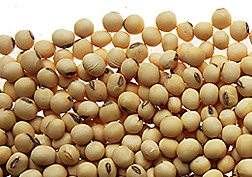Science Update
Device Detects Fruit Pits
To make sure that aficionados of sweet, succulent prunes—also known as “dried plums”—don’t crunch down on bits of pits, researchers have devised and patented a new way to detect them. As the dried plums roll along a processing line’s conveyer belt, a roller gently presses the fruit against the belt. A force transducer mounted beneath the belt reads the amount of resistance the roller encounters, and the reading goes to a signal processor linked to a computer.
Using a special mathematical formula, the computer can determine whether the reading likely indicates the presence of a plum pit or fragment. If so, the signal processor alerts a sorter to remove that plum from the processing line for retesting. Lab tests have shown that the system signals false positives only 1 percent of the time, so researchers will now work toward increasing its running speed. This pit-detecting system has potential for checking other dried stone fruits, including peaches and apricots.
Eric S. Jackson, USDA-ARS Plant Mycotoxins Research Unit, Albany, California; phone (510) 559-8868.
Gasification—An Energy Alternative
A feasibility study is under way on construction of a 1- to 2-megawatt research and development gasification facility for testing a variety of feedstocks for suitability to generate steam and electricity. It would be built at the Henry A. Wallace Beltsville (Maryland) Agricultural Research Center (BARC), the world’s largest and most diversified agricultural research complex. The study is being done under an agreement with the U.S. Department of Energy’s National Energy Technology Laboratory. Researchers at BARC would develop technologies with potential for transfer to farm co-ops and rural communities.
Gasification involves burning biomass—of plant or animal origin—to produce a gas that can be used directly for electricity production or converted into a variety of liquid fuels. Animal manures and other BARC farm wastes would be tested, along with specialty biomass crops, such as switchgrass and poplar trees.
Matt C. Smith, USDA-ARS Environmental Management and Byproduct Utilization Laboratory, Beltsville, Maryland; phone (301) 504-9100.
|
|
Natural compounds called “saponins”—found in soybeans and many other plants—are commonly used as foaming agents in shampoos and cleaning products. Now, a new method for extracting saponins from soybeans may also shed light on soy’s health-promoting potential, both as whole beans and in processed soy foods. For example, anticancer potential is being linked to group-A and -B saponins, isoflavones, and other phytochemicals in soy. Mode-of-action studies have shown that saponins can act as chemoprotectants, causing certain kinds of cancerous cells to self-destruct.
Until recently, it’s been difficult to extract soybean saponins and isoflavones for study. Now, research with University of Illinois colleagues has led to an easy-to-follow procedure that involves grinding and defatting the beans, using solvents to extract the saponins and isoflavones, and identifying individual ones by use of high-pressure liquid chromatography.
Mark A. Berhow, New Crops and Processing Technology Research Unit, USDA-ARS National Center for Agricultural Utilization Research, Peoria, Illinois; phone (309) 681-6317.
The PHACE of Rangeland CO2 Studies
It took 2 years to develop its infrastructure, but now scientists are embarking on a 5- to 10-year experiment called the “Prairie Heating and CO2 (carbon dioxide) Enrichment”—or PHACE—study. The aim is to determine the impact of simultaneous atmospheric warming and rising CO2 levels on the ecology of native Great Plains grasslands.
Before beginning, the researchers had to tailor an ecosystem model—based on earlier experimental results—to the PHACE site in southern Wyoming. That’s where they’re investigating the effects of changes in climate and CO2 on soil carbon, nitrogen (N) cycling, and forage production. They’re using a CO2 injection system and infrared heaters to raise CO2 levels and temperatures over the native prairie. First, they combined results from experimental exercises with modeling to see whether a predicted change attributable to rising atmospheric CO2—such as lower N concentrations in forage grasses—would be borne out by research. It was, which boosted confidence in the methods that will be used in the PHACE experiment.
A decline in N could lower the nutritional quality of prairie forage, which would diminish the performance of livestock and wildlife grazing it. This lengthy study, with cooperators at the Colorado State University-Fort Collins and the University of Wyoming-Laramie, should clarify the likely effects of rising temperatures and CO2 on N and other measures of quality—and the quantity—of forage grown on the semiarid rangelands of the western Great Plains.
Jack A. Morgan, USDA-ARS Rangeland Resources Research Unit, Fort Collins, Colorado; phone (970) 492-7121.
"Science Update" was published in the September 2007 issue of Agricultural Research magazine.







